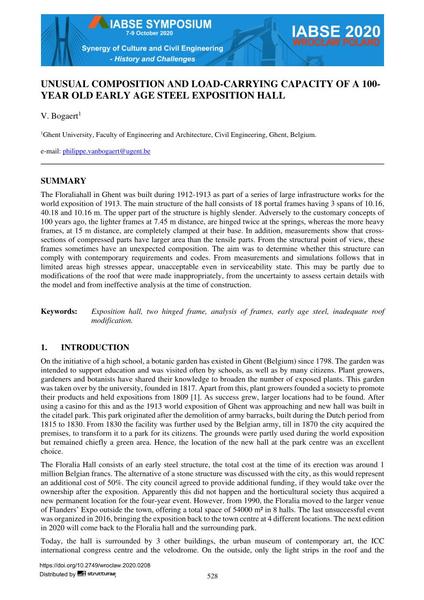Unusual Composition and Load-Carrying Capacity of a 100-Year Old Early Age Steel Exposition Hall

|
|
|||||||||||
Détails bibliographiques
| Auteur(s): |
V. Bogaert
(Ghent University, Faculty of Engineering and Architecture, Civil Engineering, Ghent, Belgium)
|
||||
|---|---|---|---|---|---|
| Médium: | papier de conférence | ||||
| Langue(s): | anglais | ||||
| Conférence: | IABSE Symposium: Synergy of Culture and Civil Engineering – History and Challenges, Wrocław, Poland, 7-9 October 2020 | ||||
| Publié dans: | IABSE Symposium Wroclaw 2020 | ||||
|
|||||
| Page(s): | 528-535 | ||||
| Nombre total de pages (du PDF): | 8 | ||||
| Année: | 2020 | ||||
| DOI: | 10.2749/wroclaw.2020.0208 | ||||
| Abstrait: |
The Floraliahall in Ghent was built during 1912-1913 as part of a series of large infrastructure works for the world exposition of 1913. The main structure of the hall consists of 18 portal frames having 3 spans of 10.16, 40.18 and 10.16 m. The upper part of the structure is highly slender. Adversely to the customary concepts of 100 years ago, the lighter frames at 7.45 m distance, are hinged twice at the springs, whereas the more heavy frames, at 15 m distance, are completely clamped at their base. In addition, measurements show that crosssections of compressed parts have larger area than the tensile parts. From the structural point of view, these frames sometimes have an unexpected composition. The aim was to determine whether this structure can comply with contemporary requirements and codes. From measurements and simulations follows that in limited areas high stresses appear, unacceptable even in serviceability state. This may be partly due to modifications of the roof that were made inappropriately, from the uncertainty to assess certain details with the model and from ineffective analysis at the time of construction. |
||||
